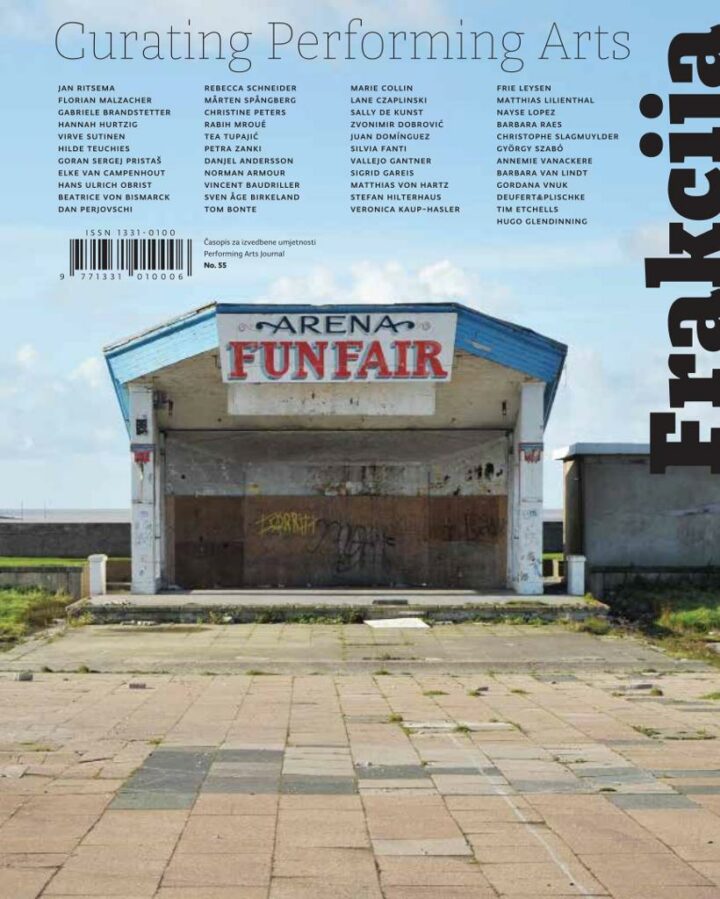The concept of curating has arrived in the field of performing arts, and with it the understanding that programming performances, theatre works, dance pieces, or music can be more than just selecting or producing shows and then inserting them into a time slot and space. There is a necessity of putting works into larger contexts, to have them interact with each other and the world that informs them. And there is a possibility of creating a collective experience not only within the performance itself, but rather turning a programme, festival, event, or venue into a larger field of communication and communing.
Even though concepts of curating within the field of visual arts are clearly more elaborated than within the performing arts, the relation between them has always been more reciprocal than is often acknowledged. After all it is no coincidence that Harald Szeemann, in many ways the prototype of a contemporary curator, compared his work to that of a theatre director, and that art theorist Beatrice von Bismarck emphasises the propinquity of an exhibition-maker’s task to that of a dramaturg.
But taking Szeemann’s idea of staging exhibitions seriously takes us even further. It raises the question of how curation not only generally borrows (and often without any awareness) the tools of theatre, performance, and choreography but rather how it could gain even more from these practices by consciously integrating their very strategies and techniques, and by understanding curation itself as performative.
Performing the Performative
The impressive (and sometimes exaggerated) career of the concept of the performative began with J. L. Austin’s ‘speech acts’, introduced in his set of lectures ‘How to Do Things with Words’ (1955). As a precursor to the idea of performativity it described verbal utterances that exercise the transformative capacity of an act that constitutes or changes reality. The mainly linguistic discourse that followed Austin was, in the early 1990s, the base for Judith Butler’s radical interpretation of gender as something that is performed and constructed via speech or physical action: reality as a social construction coming to existence by permanently repeating and quoting. Performativity for Butler is, as described in Bodies that Matter (1993), ‘that reiterative power of discourse to produce the phenomena that it regulates and constrains.’
While definitions of performativity are numerous, often contradictory, and regularly rather vague, most are connected to a constructivist belief that there are no fixed concepts of objectivity, reality, or truth, and that everything is constructed individually, influenced by context and interaction.
Influential impulses in theatre and performance studies came next to the linguist arguments from ethnographical and anthropological discourses: the term ‘cultural performance’ was introduced in 1959 by ethnologist Milton Singer’s book Traditional India: Structure and Change. Singer believed that in many cultures performances, like dances, theatre, and rituals (defined by having a dramaturgy, a division between performer and audience, a framed time, a specific reason and place etc.) enable people to reassure themselves of their traditions and identities. Anthropologist Victor Turner continued to develop the concept of cultural performance, which was picked up by theatre makers and theorists like Richard Schechner, who collaborated with Turner, applied his discoveries to theatre, and pushed them further. As different as all these concepts of the performative are they all emphasise in one way or the other its ‘reality-making capacity’, as Shannon Jackson puts it in this book.
Yet there is another strand of the use of the word ‘performative’ — equally vague and additionally rather colloquial. It describes, again in Jackson’s words, art works that are ‘theatre-like but not theatre’, mainly to ‘provide an umbrella to cluster recent crossdisciplinary work in time, in space, with bodies, in relational encounters.’ Jackson calls this the ‘intermedial use of the performative vocabulary’ that often ‘foregrounds the sometimes productive, sometimes uncomfortable, relation between the performing arts and the visual arts.’
Keeping Szeemann in mind, it is this very notion of ‘theatrelike but not theatre’ that despite often being dismissed as too literal, opens up a whole range of possibilities when applied to the processes and products of curating: how can the understanding of dramaturgy, time management, narration, process, use of space, the co-presence of the audience, role play etc. — many of which were already important for Singer’s definition of ‘cultural performance’ — inform curatorial work?

